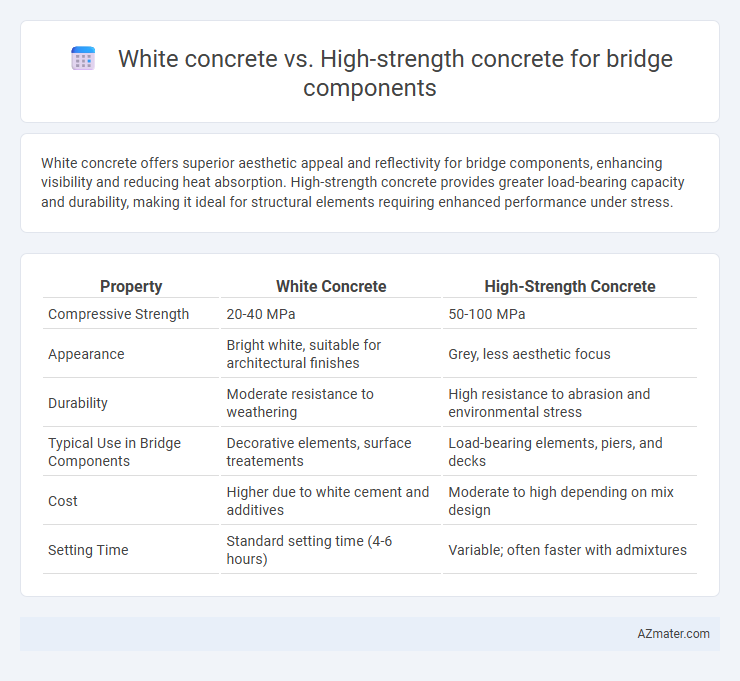White concrete offers superior aesthetic appeal and reflectivity for bridge components, enhancing visibility and reducing heat absorption. High-strength concrete provides greater load-bearing capacity and durability, making it ideal for structural elements requiring enhanced performance under stress.
Table of Comparison
| Property | White Concrete | High-Strength Concrete |
|---|---|---|
| Compressive Strength | 20-40 MPa | 50-100 MPa |
| Appearance | Bright white, suitable for architectural finishes | Grey, less aesthetic focus |
| Durability | Moderate resistance to weathering | High resistance to abrasion and environmental stress |
| Typical Use in Bridge Components | Decorative elements, surface treatements | Load-bearing elements, piers, and decks |
| Cost | Higher due to white cement and additives | Moderate to high depending on mix design |
| Setting Time | Standard setting time (4-6 hours) | Variable; often faster with admixtures |
Overview of White Concrete and High-Strength Concrete
White concrete is characterized by its aesthetic appeal, using white Portland cement to achieve a bright, clean finish often preferred for architectural bridge components. High-strength concrete, designed with compressive strengths exceeding 6,000 psi, provides enhanced durability and load-bearing capacity, essential for critical structural elements in bridge construction. Both types optimize specific performance criteria: white concrete for visual impact and high-strength concrete for structural resilience.
Key Material Properties Comparison
White concrete offers superior aesthetic appeal with its high reflectivity and light color, making it ideal for architectural bridge components requiring visual prominence. High-strength concrete typically features compressive strengths exceeding 6000 psi, providing enhanced load-bearing capacity and durability essential for structural elements subjected to heavy stresses. The key material property distinction lies in white concrete's optimized pigment and aggregate selection for appearance, whereas high-strength concrete emphasizes optimized cementitious content and admixtures for mechanical performance.
Aesthetic Benefits for Bridge Design
White concrete enhances bridge components by providing a visually appealing, clean, and uniform surface that reflects natural light, creating an elegant and modern appearance. High-strength concrete offers structural advantages but typically has a duller, gray finish that may require additional coatings or treatments to improve aesthetics. Utilizing white concrete in bridge design supports architectural creativity and contributes to landmark structures with striking visual impact.
Structural Performance and Load-Bearing Capacity
White concrete offers excellent aesthetic appeal and moderate structural performance, making it ideal for visible bridge components where architectural design is critical. High-strength concrete provides superior load-bearing capacity and enhanced durability, significantly improving the structural integrity of load-bearing bridge elements subjected to heavy traffic and dynamic forces. Optimizing mix design and curing methods for high-strength concrete ensures improved compressive strength exceeding 50 MPa, essential for critical bridge components requiring maximum performance.
Durability and Long-Term Maintenance
White concrete, known for its aesthetic appeal and moderate strength, offers satisfactory durability for bridge components but may require more frequent maintenance due to its susceptibility to surface wear and environmental staining. High-strength concrete provides superior durability through enhanced compressive strength and reduced permeability, significantly minimizing risks of cracking, corrosion, and long-term deterioration under heavy loads and harsh conditions. Selecting high-strength concrete for critical bridge elements ensures prolonged service life and reduced maintenance costs, optimizing structural integrity and resilience.
Cost Considerations and Economic Efficiency
White concrete typically incurs higher material costs due to the use of specialized white cement and aggregates, making it less economical for large-scale bridge components compared to high-strength concrete. High-strength concrete offers superior load-bearing capacity and durability, reducing maintenance expenses and extending bridge lifespan, which enhances long-term economic efficiency. Evaluating initial costs alongside lifecycle performance and maintenance requirements is crucial for optimizing budget allocation in bridge construction projects.
Environmental Impact and Sustainability
White concrete, with its higher albedo, reflects more sunlight reducing urban heat island effects and lowering cooling energy demands in surrounding areas, promoting environmental sustainability. High-strength concrete, often requiring greater cement content, can have a larger carbon footprint due to increased CO2 emissions during production, though it enables slimmer, longer-lasting bridge components reducing overall material use and maintenance frequency. Balancing white concrete's reflective benefits with high-strength concrete's structural efficiency is key to optimizing bridge sustainability and minimizing environmental impact.
Suitability for Various Bridge Components
White concrete offers excellent aesthetic appeal and is highly suitable for decorative bridge components such as facades, parapets, and architectural panels. High-strength concrete provides superior load-bearing capacity, making it ideal for structural elements like beams, piers, and decks where durability and resistance to heavy loads are critical. The choice between white concrete and high-strength concrete depends on the functional requirements and visual importance of specific bridge components.
Case Studies of Bridge Projects
White concrete, known for its aesthetic appeal and moderate strength, has been effectively used in bridge components such as parapets and pedestrian walkways, demonstrated in the Chapel Bridge renovation in Switzerland, where its reflective properties enhanced visibility and durability. High-strength concrete, with compressive strengths exceeding 70 MPa, is preferred in load-bearing elements like piers and girders, as seen in the Millau Viaduct in France, enabling slender designs and longer spans under heavy traffic loads. Case studies highlight that combining white concrete for architectural finishes with high-strength concrete for structural integrity optimizes both visual impact and performance in modern bridge engineering.
Choosing the Right Concrete for Bridge Applications
White concrete offers aesthetic appeal and enhanced reflectivity, making it suitable for architectural bridge components requiring visual prominence and heat reduction. High-strength concrete provides superior compressive strength and durability, ideal for load-bearing bridge elements subjected to heavy traffic and harsh environmental conditions. Selecting the right concrete depends on balancing structural demands with design requirements, ensuring performance and longevity in bridge construction.

Infographic: White concrete vs High-strength concrete for Bridge component
 azmater.com
azmater.com